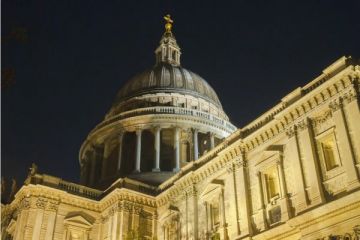by Pam Mather
Note: This guide was written in the fall of 1998 for a friend who was going to live in London on the BUNAC program. Therefore, some of the information will be outdated.
Background - Why I lived in London
I lived in London from May through November 1997 with two of my friends, Anne and Kristina. The three of us worked as temps in central London. We lived in two flats during our stay, because the first one we lived in was due to be renovated four months into our stay. At the end of September, we moved to a second flat with a fourth roommate, Marianne.
What is BUNAC?
US students need work permits to take employment (paid or unpaid) in Britain. The employer has the difficult task of justifying the employment of a foreigner, and they must demonstrate that the student has more skills than resident applicants. This is where BUNAC (the British Universities North America Club) steps in. They issue a Student Employment Exchange Program Blue Card, which relieves companies of the burden. The program is fully approved by the British Government as a reciprocal exchange. The Blue Card is available to all US citizens ages 18 and upwards, who are full-time students in the USA.
The main office of BUNAC is in central London, and provides program participants with leads on accommodations and employment, but it is up to each participant to find their own place to live and work.
Before You Go
How to get a cheap plane ticket
When shopping for your plane ticket, try Council Travel and STA Travel. They offer affordable rates, and the cost of changing your ticket will be similarly low. In addition, they have offices in central London that can take care of any problems you may have.
You may be tempted to use a courier service or some other kind of agency that requires great flexibility in your leaving dates. I would not recommend this, as you will need to have firm plans before you go so you can reserve a hostel.
How much money you will need
The program requires you to bring a minimum of $1000 to Britain, but I strongly urge you to bring double that or more (or have access to that amount through credit cards, etc.) to cover expenses such as advance rent and security deposits which may be incurred before you receive your first wages.
Other expenditures
Once you have gone through with your BUNAC orientation, you will discover the unpleasant fact that you must register with the police. You must bring a passport-sized photo and £34 (fortunately, they take credit cards). They will give you a passport-sized booklet with your picture in it and some official-looking stamps. As usual, this will involve standing in a long, long queue.
What to pack
What you will pack depends, of course, on when you will be going. London is fairly temperate. It never gets very hot in the summer, and it rarely gets cold enough to freeze in the winter. But it is rainy almost all year long. While we were there, June was grey and chilly, July was gorgeous and sunny, and August was quite warm.
No matter what the season, the nights will be much colder than the day, so bring warm sweaters and jackets. If you will be there in the summer, a sweater and a medium weight jacket should suffice. If you are going in the winter, bring a heavy coat and lots of clothes with which to layer.
Above all, bring comfortable shoes. Bring casual shoes and nice shoes for work, but the most important thing to remember is that you will be walking a lot, and your shoes must be up to it.
You can find all of the toiletries you will need at a local chemist like Boots or at a grocery store like Sainsbury’s. Don’t worry about bringing a ton of extra toothpaste or deodorant (like I did) because it will just take up valuable suitcase space.
In addition, pack photocopies of your passport, blue card, and any other forms of identification that you may be bringing with you. Also, bring a copy of your bank statement, for two reasons. First of all, you may be asked to prove how much money you are bringing to the UK. Second of all, when you go to open a bank account, you may need it as a reference.
Different customs
While trying to learn the many different customs that the English have, the best thing to do is just observe. You will be amazed at the many tiny differences from America, and it would be impossible to list them all here. Here, though, are some of the big ones.
Money
British money is quite different from American money. The basic monetary unit is the pound. Unlike the dollar, however, the pound comes in coin form, so you will probably find yourself carrying around more coins than notes (as they call bills.) The coin denominations are 1p, 2p, 5p, 10p, 20p, 50p, £1 and £2. The most common banknotes are £5, £10 and £20, though they do go higher. (Not that I ever saw any!) About thirty years ago, the British decimalized their monetary system, so you will no longer find shillings or drams.
Doing laundry
If you’re like me and don’t relish the thought of washing your clothes in the bathroom sink, take a walk around your neighbourhood and look for a launderette. There is likely to be one near to where you live, but there are several considerations when picking the one you will use.
As they say in real estate, the most important factor is location, location, location. Remember you will be lugging a big, heavy bag of laundry to and from your flat approximately once a week. Secondly, check the prices. Most washers are approximately 70p, and dryers are about 20p per cycle, but the cycles are short and you may find yourself using several dryers for several cycles each. If there is a spin dryer (about 20p,) use it, because it will save you a lot of time and money when you go to dry your clothes in the regular dryer. (The spin dryer merely spins your clothes to get rid of excess water, like the spin cycle on the washing machine.)
Calling home
When calling home, the best thing to do is buy an international phone card. They come in many different denominations and calls cost as little as 10p per minute. Do not buy a BT phone card, or you will find yourself paying £2 per minute for your call. Save the BT cards for making local phone calls. You can purchase international phone cards in newsagents and grocery shops. To dial the United States, dial 00 1 (area code) phone number. For example, 00 1 504 555 1234.
Calling around the UK
Unlike in the United States, local calls cost money. Therefore, it is wise to carry around a BT phone card in case you do not have any change. (Without one, you will have to insert more money as the call goes on, unlike in the US, when you can talk just about as long as you like after putting in 35 cents.) London is divided into two calling zones, 0171 for inner London and 0181 for outside the city centre. [Editor: This is outdated information. London now uses the 020 area code.] You must dial the proper code if you are calling outside the zone you are in. If you are calling outside London, you may find yourself dialling a number that has 9 or more digits. Phone numbers are not standardized like they are in the United States, but local calls will always begin in 0.
Getting around London
Public transportation in London is a wonderful thing. It is affordable and comprehensive, if not extremely reliable. But if you allow extra time in the morning for late buses and slow trains, you will be pleased by its services.
When you arrive in the city, purchase a week-long pass for Zones 1-3. You won’t know yet where you will be looking at flats, and zone extensions can add up quickly (60p per zone, each way.) You will be able to use the pass for the Underground and the bus, including the night bus. Bring a passport-sized photo for the ID portion of the pass.
The Underground
When using the Underground, or “the tube,” as the locals call it, there are a few things to remember. The Underground is divided into six zones, which are rough concentric circles. The city centre is in zone 1, and most places you will go are in this or zone 2. Study your route before you go somewhere on the tube, and check on a regular map as well. The Underground map is not drawn to scale. Therefore, you will find that many times, one tube station is within walking distance to another, and it will be much quicker to just walk.
The bus
Ahh...the classic red double-decker bus. One of the quintessential symbols of London that is, unfortunately, disappearing. Riding a bus can give you a much better grasp on how the city is laid out than the Underground can, but it is also generally much slower. One major advantage of the bus is that you should be able to get off much closer to your destination than if you took the tube.
There are two main types of buses in London now, the Routemaster bus and the driver operated bus. The first kind is the type where you get on at the back and a conductor takes your fare or checks your travel pass. Unfortunately, these are waning in number, as they are inefficient to run. These are the classic symbols of London. The other type, which is not even always double-decker, is completely driver-operated. When you get on, you show the driver your pass or give him your fare. These buses are frustrating because of the long waits at each stop while the driver lets people on.
The most important thing, though, is to ride on the top level. You will get fantastic views of the city and you will be able to understand the layout of the city far better than if you sit on the bottom, where you can’t actually see much.
Night buses
The night bus network can be a godsend to the cash strapped. The main hub of the night bus network is Trafalgar Square, which is in easy walking distance of most nightspots (Covent Garden, Leicester Square, Piccadilly Circus). Just be sure to stay with a group of friends, as the dark alleys near the bus stops can be havens for unsavoury characters. Some night buses also leave from Victoria Station, but seeing as there are few places to go out in that area, it is unlikely you will find yourself there late at night. If you are nowhere near either of these two places, check the bus stops where you are. If there are any buses listed with an “N” after the number, you have found a night bus that should be going to Trafalgar Square, if not your destination. (If it seems like they are going away from the city centre, cross the street and check the bus stop over there.)
London Taxis
Taking a classic London black taxi is a splurge, to be sure, but if you are feeling flush and don’t have too far to go, it is worth every penny.
Simply stand out on a busy street, raise your arm, and soon, a cab should stop at the curb in front of you. Step up to the driver’s window, tell him or her where you want to go, and get in the back.
Nonetheless, no matter how obscure you think the place you are going is, if it is in central London, your driver will find it. All taxi drivers must learn The Knowledge, an exhaustive test that involves learning every street and landmark in the city centre.
Your driver may engage you in conversation - talk to them, you might learn something. And when your wild ride is over, pay the driver and be sure to leave a 10-15% tip.
Page 1 • Page 2 • Page 3 (Going Out) • Page 4 (Shopping)
Pam Mather is a New Orleans-based Anglophile. She lived in London for six months in 1997 and goes back for a visit every year.



